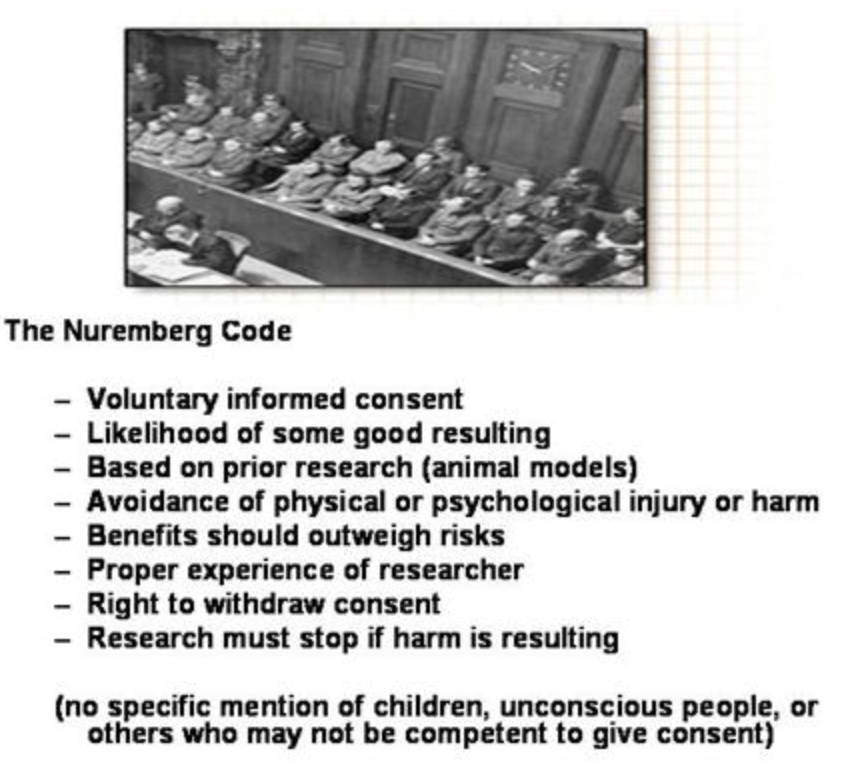As I walked through the corridors of the Education wing of the hospital and entered into the anatomy lab, I was intrigued by the specimens laid out in front of me. The solemn aura in the room overcame me as we explored the cadavers before us. A sense of immense respect for the specimens occupied the room. I began to reflect on the journey and evolution of ethical medical research that led to the situation I was, at that exact moment, standing in.
The Nuremberg Trials
During World War II, many deadly experiments on thousands of prisoners were undertaken without their permission. These experiments were undertaken without consent, in inhumane conditions, and with concerning research standards.
Such experiments were conducted with intention to facilitate survival of military personnel, test drugs, and advance Nazi racial goals. These included, and were not limited to:
- High-altitude experiments (to determine the maximum altitude from which damaged aircraft crews could parachute to safety)
- Freezing experiments (in order to find treatment to hypothermia)
- Testing antibodies for treatment of contagious diseases (malaria, typhus, tuberculosis, typhoid fever, yellow fever, infectious hepatitis)
- Sterilisation experiments on children
- Experimentation on child twins
- Disfiguration and torture
From these experiments it is clear that no moral or ethical guideline was followed, especially in consent to being utilised in such examinations as highlighted by the tests on children. It has been since stated that those that died were dissected and studied, and their surviving twins were killed and subjected to the same scrutiny. The expendable nature of the subjects in these experiments, combined with the inhumane conditions, led to what would be known as, the Nuremberg Trials.
“Survivors of medical atrocities are able to confront history and point to the inadequacies of care and compensation”
-Paul Weindling
From 1945 to 1946, 23 physicians and scientists were prosecuted for mass murder in the form of euthanasia, and human experimentation in Nazi concentration camps. They were under trial for their willing participation in war crime and crimes against humanity, with it sparking ethical questions in the medical approach to the inhumane experiments on prisoners in the Auschwitz concentration camp. As a result, seven of the doctors were found guilty and sentenced to prison, and twelve sentenced to death. From this significant trial was formed the Nuremberg Code, a statement of ten points delimiting medical experiments on human subjects , shaping the future of medical ethics.
The Nuremberg Code
From these trials was formed the Nuremberg Code. Consisting of a ten point statement , this code’s purpose was to delimit permissible medical experiments on human subjects.
In summary..

In the half century after the trial, the code informed numerous international ethics statements.It did not however have established legal force. Due to this, some argue that it would be incorrect to credit it as the framework on which ethical codes have since been based.
My Thoughts…
In my opinion, the Nuremberg code serves as a landmark document on medical ethics from one of the most significant humanitarian crises in history. For this alone, I believe that these ten statements have significance in the evolution of medical ethics of human specimens, acting as the baseline for further ethic codes developed afterwards, such as Beauchamp and Childress’ Principles of Biomedical Ethics (1979), and Medicines for Human Use (Clinical Trials) Regulations (2004).
This is an excellent blog with lots of reflective thoughts on the development of ethics in medicine. You have used text formatting, hyperlinks and multimedia very well. You could improve your blog by the addition of your own multimedia.